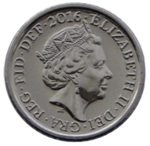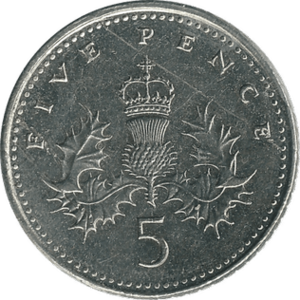Five pence (British coin) facts for kids
| United Kingdom | |
| Value | £0.05 |
|---|---|
| Mass | (1968–1990) 5.65 g (1990–present) 3.25 g |
| Diameter | (1968–1990) 23.59 mm (1990–present) 18.00 mm |
| Thickness | (Cupro-nickel) 1.7 mm (Steel) 1.89 mm |
| Edge | Milled |
| Composition | Cupronickel (1968–2010) Nickel-plated steel (2011–) |
| Years of minting | 1968–present |
| Obverse | |
 |
|
| Design | Queen Elizabeth II |
| Designer | Jody Clark |
| Design date | 2015 |
| Reverse | |
 |
|
| Design | Segment of the Royal Shield |
| Designer | Matthew Dent |
| Design date | 2008 |
The British five pence coin, often called 5p, is a coin used in the UK. It's worth five hundredths of a pound, or £0.05. This coin was first introduced on 23 April 1968. It replaced the old shilling coin. This change was made to get ready for "Decimal Day" in 1971, when the UK switched to a decimal money system.
When it was first made, the 5p coin was the same size as the shilling. The shilling even stayed as legal money for a while! But in June 1990, a smaller 5p coin was introduced. The older, larger coins were then taken out of circulation by the end of 1990.
Since its beginning, the front (obverse) of the 5p coin has shown a picture of Queen Elizabeth II. Four different portraits of the Queen have been used over the years. The newest one, designed by Jody Clark, came out in 2015. The back (reverse) of the coin has also changed. The current design, showing part of the Royal Shield, was introduced in 2008.
Contents
What is the 5p Coin Made Of?
When the five pence coin was first made, it was created from a mix of metals called cupro-nickel. This mix is 75% copper and 25% nickel.
However, since 2011, the price of these metals has gone up. Because of this, the 5p coin is now made from steel that has been covered with nickel. This change helps save money. The Royal Mint, which makes the coins, started slowly replacing the older cupro-nickel coins with the new steel ones in 2013.
How Many 5p Coins Are There?
Lots of 5p coins are used every day! In March 2014, it was thought that there were about 3,847 million (that's over 3.8 billion!) 5p coins being used. All these coins together were worth about £192.37 million.
The Look of the 5p Coin
The 5p coin has changed its look a few times over the years. Both the front (obverse) and the back (reverse) have had different designs.
Early Reverse Designs
The first design for the back of the coin was used from 1968 to 2008. It was created by Christopher Ironside. This design showed a crowned thistle, which is a symbol of Scotland. Below the thistle, you could see the number "5". Above it, the words either said "NEW PENCE" (from 1968 to 1981) or "FIVE PENCE" (from 1982 to 2008).
Queen Elizabeth II's Portraits
The front of the coin always features a portrait of Queen Elizabeth II. The words around the portrait usually say "ELIZABETH II D.G.REG.F.D." followed by the year the coin was made. The letters "D.G.REG.F.D." are a Latin abbreviation that means "By the Grace of God, Queen, Defender of the Faith."
- First Portrait (1968–1984): The very first portrait of the Queen was designed by Arnold Machin. In this picture, the Queen wears a special crown called the 'Girls of Great Britain and Ireland' Tiara.
- Second Portrait (1985–1997): Later, a portrait by Raphael Maklouf was used. For this design, the Queen wore the George IV State Diadem crown.
- Third Portrait (1998–2015): From 1998, the portrait by Ian Rank-Broadley was featured. This one also showed the Queen wearing the 'Girls of Great Britain and Ireland' Tiara. You can often see the designer's initials, "IRB", below this portrait.
- Fourth Portrait (2015–Present): Since June 2015, coins with a new portrait by Jody Clark have been in circulation.
Size Change in 1990
On 27 June 1990, the 5p coin became smaller. The design on the coin stayed the same, but its size changed. The older, larger 5p coins were taken out of circulation by 31 December 1990.
New Reverse Designs (2008 Onwards)
In 2005, the Royal Mint held a competition to create new designs for many of the UK's coins. The winner, announced in 2008, was Matthew Dent. His designs were slowly introduced starting in mid-2008.
Matthew Dent's designs for the 1p, 2p, 5p, 10p, 20p, and 50p coins all show parts of the Royal Shield. When you put these coins together, they form the complete shield! The 5p coin shows the very center of the Royal Shield, where the four different sections meet.
With these new designs, the small dots around the edge of the coin, called "beading," were removed from both the front and back of the 5p coin.
What Does "Legal Tender" Mean?
When a coin is "legal tender," it means it can be officially used to pay off a debt. For example, if you owe someone money, they must accept 5p coins up to a total of £5.
However, "legal tender" doesn't mean a shop has to accept your coins for everyday shopping. Shops can choose what kind of payment they accept. So, while a 5p coin is legal tender for debts, a shopkeeper can still decide if they want to take it for your purchase.


